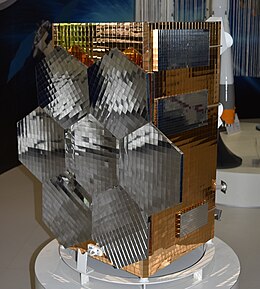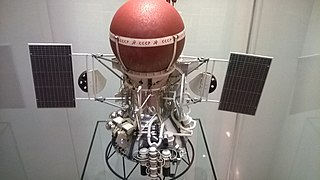
Venera 10, or 4V-1 No. 661, was a Soviet uncrewed space mission to Venus. It consisted of an orbiter and a lander. It was launched on June 14, 1975, 03:00:31 UTC and had a mass of 5033 kg (11096 lb).
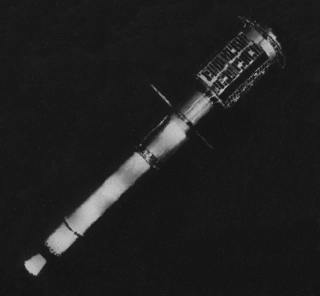
Explorer 11 was a NASA satellite that carried the first space-borne gamma-ray telescope. This marked the beginning of space gamma-ray astronomy. Launched on 27 April 1961 by a Juno II, the satellite returned data until 17 November 1961, when power supply problems ended the science mission. During the spacecraft's seven-month lifespan it detected twenty-two events from gamma-rays and approximately 22,000 events from cosmic radiation.

The INTErnational Gamma-Ray Astrophysics Laboratory (INTEGRAL) is a space telescope for observing gamma rays of energies up to 8 MeV. It was launched by the European Space Agency (ESA) into Earth orbit in 2002, and is designed to provide imaging and spectroscopy of cosmic sources. In the MeV energy range, it is the most sensitive gamma ray observatory in space. It is sensitive to higher energy photons than X-ray instruments such as NuSTAR, the Neil Gehrels Swift Observatory, XMM-Newton, and lower than other gamma-ray instruments such Fermi and HESS.

The Global Geospace Science (GGS) Wind satellite is a NASA science spacecraft designed to study radio waves and plasma that occur in the solar wind and in the Earth's magnetosphere. It was launched on 1 November 1994, at 09:31:00 UTC, from launch pad LC-17B at Cape Canaveral Air Force Station (CCAFS) in Merritt Island, Florida, aboard a McDonnell Douglas Delta II 7925-10 rocket. Wind was designed and manufactured by Martin Marietta Astro Space Division in East Windsor Township, New Jersey. The satellite is a spin-stabilized cylindrical satellite with a diameter of 2.4 m and a height of 1.8 m.

The Russian Space Research Institute is the leading organization of the Russian Academy of Sciences on space exploration to benefit fundamental science. It was formerly known as the Space Research Institute of the USSR Academy of Sciences. It is usually known by the shorter name Space Research Institute and especially by the initialism IKI.

Spektr-R was a Russian scientific satellite with a 10 m (33 ft) radio telescope on board. It was launched on 18 July 2011 on a Zenit-3F launcher from Baikonur Cosmodrome, and was designed to perform research on the structure and dynamics of radio sources within and beyond the Milky Way. Together with some of the largest ground-based radio telescopes, the Spektr-R formed interferometric baselines extending up to 350,000 km (220,000 mi).
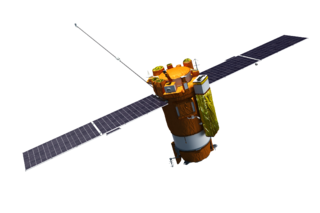
Koronas-Foton, also known as CORONAS-Photon, was a Russian Solar research satellite. It is the third satellite in the Russian Coronas programme, and part of the international Living With a Star programme. It was launched on 30 January 2009, from Site 32/2 at the Plesetsk Cosmodrome, aboard the final flight of the Tsyklon-3 rocket. On 1 December 2009 all scientific instruments on the satellite were turned off due to the problems with power supply that were caused by a design flaw. On 18 April 2010 the creators of the satellite announced it was lost "with a good deal of certainty".

Gamma-ray astronomy is the astronomical observation of gamma rays, the most energetic form of electromagnetic radiation, with photon energies above 100 keV. Radiation below 100 keV is classified as X-rays and is the subject of X-ray astronomy.

Explorer 14, also called EPE-B or Energetic Particles Explorer-B, was a NASA spacecraft instrumented to measure cosmic-ray particles, trapped particles, solar wind protons, and magnetospheric and interplanetary magnetic fields. It was the second of the S-3 series of spacecraft, which also included Explorer 12, 14, 15, and 26. It was launched on 2 October 1962, aboard a Thor-Delta launch vehicle.
Electron Losses and Fields Investigation (ELFIN) is a nanosatellite developed by University of California, Los Angeles (UCLA). ELFIN is a 3U+ CubeSat designed to study space weather, specifically, the loss of relativistic electrons in the radiation belts. ELFIN was a participant in the Air Force Research Lab's University Nanosatellite Program and is currently funded by NASA's Low Cost Access to Space program and the National Science Foundation.

The Ultra-Fast Flash Observatory (UFFO) Pathfinder is a space observatory measuring prompt emission of gamma-ray bursts (GRB) both in optical/UV and in X-ray range down to sub-second timescales for the first time. Instead of turning the whole satellite towards GRB location like the Swift Gamma-Ray Burst Mission, UFFO employs a slewing mirror telescope approach – the optical path of the telescope is changed by rotation of motorized mirror within ~1 second after burst was detected.

Explorer 12, also called EPE-A or Energetic Particles Explorer-A and as S3), was a NASA satellite built to measure the solar wind, cosmic rays, and the Earth's magnetic field. It was the first of the S-3 series of spacecraft, which also included Explorer 12, 14, 15, and 26. It was launched on 16 August 1961, aboard a Thor-Delta launch vehicle. It ceased transmitting on 6 December 1961 due to power failure.
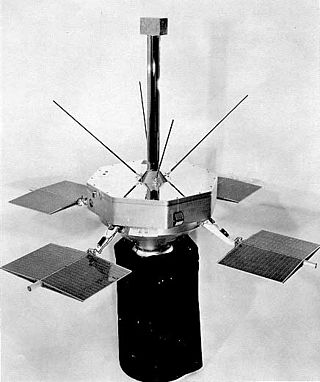
Explorer 15, also called EPE-C or Energetic Particles Explorer-C, was a NASA satellite launched as part of the Explorer program. Explorer 15 was launched on 27 October 1962, at Cape Canaveral Air Force Station, Florida, United States, with a Thor-Delta A.

Explorer 21, also called IMP-B, IMP-2 and Interplanetary Monitoring Platform-2, was a NASA satellite launched as part of Explorer program. Explorer 21 was launched on 4 October 1964, at 03:45:00 GMT from Cape Canaveral (CCAFS), Florida, with a Thor-Delta C launch vehicle. Explorer 21 was the second satellite of the Interplanetary Monitoring Platform, and used the same general design as its predecessor, Explorer 18 (IMP-A), launched the previous year, in November 1963. The following Explorer 28 (IMP-C), launched in May 1965, also used a similar design.
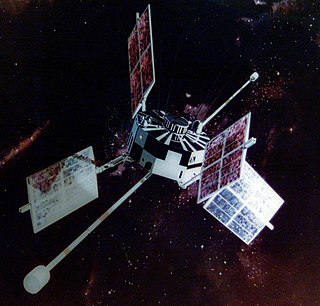
Explorer 34, was a NASA satellite launched as part of Explorer program. Explorer 34 as launched on 24 May 1967 from Vandenberg Air Force Base, California, with Thor-Delta E1 launch vehicle. Explorer 34 was the fifth satellite launched as part of the Interplanetary Monitoring Platform program, but was known as "IMP-4" because the preceding launch was more specifically part of the "Anchored IMP" sub-program. The spacecraft was put into space between the launches of Explorer 33 in 1966 and Explorer 35 in July 1967, but the next satellite to use Explorer 34's general design was Explorer 41, which flew in 1969.

Explorer 41, also called as IMP-G and IMP-5, was a NASA satellite launched as part of Explorer program. Explorer 41 as launched on 21 June 1969 on Vandenberg AFB, California, with a Thor-Delta E1 launch vehicle. Explorer 41 was the seventh satellite launched as part of the overall Interplanetary Monitoring Platform series, though it received the post-launch designation "IMP-5" because two previous flights had used the "AIMP" designation instead. It was preceded by the second of those flights, Explorer 35, launched in July 1967. Its predecessor in the strict IMP series of launches was Explorer 34, launched in May 1967, which shared a similar design to Explorer 41. The next launch was of an IMP satellite was Explorer 43 in 1971.
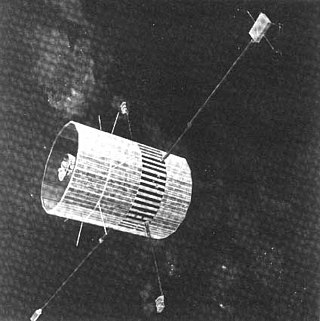
Explorer 47, was a NASA satellite launched as part of Explorer program. Explorer 47 was launched on 23 September 1972 from Cape Canaveral, Florida, with a Thor-Delta 1604. Explorer 47 was the ninth overall launch of the Interplanetary Monitoring Platform series, but received the launch designation "IMP-7" because two previous "Anchored IMP" flights had used "AIMP" instead.

Vela 2A, also known as Vela 3, Vela Hotel 3 and OPS 3662, was a U.S. military satellite developed to detect nuclear detonations to monitor compliance with the 1963 Partial Test Ban Treaty by the Soviet Union. The secondary task of the ship was space research.

Vela 2B was a U.S. reconnaissance satellite for detecting explosions and nuclear tests on land and in space, the first of the second pair of Vela series satellites, taken together with Vela 2A and ERS 13 satellites. The secondary task of the ship was space research.

Vela 3B was a U.S. reconnaissance satellite to detect explosions and nuclear tests on land and in space; the first of the third pair of Vela series satellites; taken together with Vela 3A and ERS 17 satellites.
